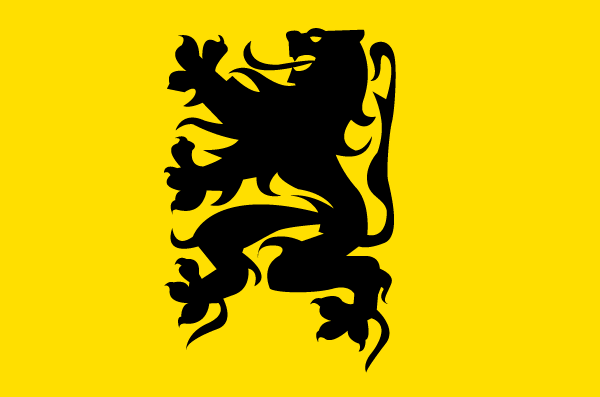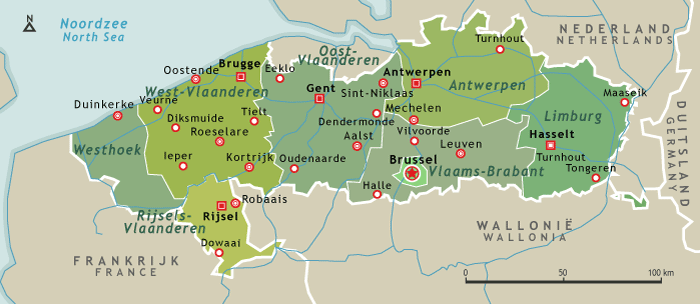Flanders, the long march towards emancipation

Populated by more than 7 million inhabitants including Brussels, Flanders can be considered as the Netherlands of the south. This is the gateway to the Germanic world on the North Sea. Since the beginning of the 14th century, the Flemish have protected their identity in the face of attempts at forced linguistic assimilation.

That which we now call Flanders has never been united in a single state. In the Middle Ages, the territory was divided between many feudal states, the most important being the county of Flanders, the duchy of Brabant and the county of Loon. The county of Flanders belonged to the French crown, while other territories were part of the Germanic Holy Roman Empire, except for the county of Loon, which was part of the principality-bishopric of Liège. Later, the county of Flanders and the duchy of Brabant made up part of the twenty-six provinces, roughly corresponding to the current Bénélux. The latter were dependent on Charles V. In 1581, after the Reformation, the twenty-six provinces declared their independence, except for the southern Netherlands (Belgium) which remained under Spanish and Catholic rule. Between the 16th and 18th centuries, conflicts between the French, the Austrians and the Spanish in Flanders led to the creation of a new kingdom, through the congress of Vienna, uniting both the Netherlands and present-day Belgium. But during the Belgian revolution, Belgium broke away and French became the only official language, forcing the Flemish to resist.
Despite significant advances after the Second World War, the Flemish remained weak. Only in 1971, with the creation of the Council of the Dutch Cultural Community was some autonomy granted, re-enforced by the creation of a parliament in 1980. Today, following the political crisis in Belgium, the question of Flemish independence arises again.

Identity card

| Name | Vlaanderen | Flemish/Dutch Flandre | French (Flanders) |
| Population | 7,000,000 inhab. (including 6,589,069 in official Flanders) (2019) |
| Area | 16,000 km² |
| Languages | Vlaams/Nederlands | Flemish/Dutch (official) Français | French |
| Number of native speakers | 6,500,000 | Flemish/Dutch (2016) |
| State of guardianship | Belgium, France |
| Official status | Region and community in Belgium |
| Capital | Brussel | Flemish/Dutch Bruxelles | French (Brussels) |
| Historic religion | Roman Catholic |
| Flag | De Vlaamse Leeuw | Flemish/Dutch (The Flemish Lion) |
| Anthem | De Vlaamse Leeuw | Flemish/Dutch (The Flemish Lion) |
| Motto | None |

Timeline

- 58–51 BC • Julius Caesar conquers Gaul and lays the foundations of the Roman- Germanic language.
- 1302 • Battle of the Golden Spurs. An army of Flemish citizens defeats the army of the king of France, Philip IV (the Fair).
- 1568–1648 • Revolt of the seventeen provinces of the Netherlands against the Spanish kingdom.
- 1815 • Congress of Vienna. Creation of the United Kingdom of the Netherlands.
- 1830 • Belgian revolution, separation of Belgium from the northern part of the Netherlands.
- 1914–18 • Flemish movement for peace following the atrocities of the war.
- 1971 • Creation of the Council of the Dutch Cultural Community in Belgium. In 1980, the council is transformed into a Flemish parliament.
- 2007 • Political crisis in Belgium. The Flemish wish for more autonomy. The Walloons wish for a status quo.
- 2010 • Historic victory for Flemish separatists. The New Flemish Alliance wins 29% of votes in Flanders.

Brief history

On 11 July 1302, the Battle of the Golden Spurs took place in Groeninge near Kortrijk. The urban population army (“communiers”) summarily defeat the French. After the battle, the golden spurs of the French knights were collected and hung in the tower of the Church of Our Lady in Kortrijk, hence its name. The exact reason for this conflict was the imprisonment of Count Guy I of Flanders by the king of France, Philip IV the Fair, on accusations of treason. The king seized the county and appointed French officials to Bruges to lead the new conflicts. The king then formed an army of knights that was defeated. In the 19th century, Hendrik Consience wrote the “Lion of Flanders”, based on this battle, thus developing a strong sense of identity. Today, 11 July is the day of national celebration in Flanders.

Geography

Flanders is situated in the centre of Europe, on the edge of the North Sea. It is a crossroads between France to the west, Wallonia to the south, the Netherlands to the north and Germany to the east (a few kilometres from a narrow strip belonging to the Netherlands). It is called the “flat country”, despite a few hills that are found in the south. Along with the Netherlands and Bangladesh, Flanders is one of the most densely populated areas in the world. The economic centre of Flanders was located to the west, especially in Bruges and Ghent, which were the equal of Paris or London. Later, when their power diminished, the centre of gravity moved towards the east, in particular to Antwerp and Brussels. Antwerp was developed thanks to the Industrial Revolution, which also saw the construction of the first railway between Brussels and Mechelen. At the end of the 20th century, Flanders successfully launched into new technologies and services, ensuring its economic prosperity today.



Politics now

Today, the Flemish government has the ability to manage culture, education, the environment, agriculture, communication and, for a large part, health and the economy. In other domains, such as defence or justice, there is little or no power and it has to cooperate with the Belgian federal government. A large number of parties exist Flanders. Since the legislative elections of 2010, the parliament is dominated by moderate separatists of the N-VA. The latter wish that the bulk of the powers be entrusted to the regions, a preliminary step towards independence. The detestable party of the far-right Vlaams Belang (English: Flemish Interest) necessitate other parties to form unnatural but necessary coalitions, bringing conservatives and progressives together, to prevent the spread of Vlaams Belang ideologies.
Principal separatist Flemish parties
- Nieuw-Vlaamse alliantie / New Flemish Alliance (N-VA) (Separatist conservative)
- Vlaams Belang / Flemish Interest (VB) (Far-right separatist)

